The Influence of Meteorology and Air Transport on CO2 Atmospheric Distribution over South Africa
Abstract
1. Introduction
2. Materials and Methods
2.1. CO2 Analysis
2.1.1. Tropospheric Emission Spectrometer (TES) Instrument
2.1.2. Ground Station CO2 Data
2.1.3. CO2 Study Region Locations and Description
2.1.4. CO2 Data Analysis
2.2. Atmospheric Circulation Analysis
2.3. Air Transport Analysis
Hybrid Single-Particle Lagrangian Integrated Trajectories (HYSPLIT) Atmospheric Transport Model
3. Results
3.1. TES and Global Atmosphere Watch (GAW) Station Comparison
3.2. Seasonal CO2 Relative Surface Loading at the Study Areas
3.3. The Influence of Stable Layers in the CO2 Vertical Distribution in South Africa
3.4. Seasonal Circulation Patterns at Different Levels of the Troposphere over Southern Africa and the South Atlantic Ocean
3.5. Seasonal Air Transport Backward Trajectories at Different Layers of The Troposphere in South Africa
3.5.1. Cape Town
3.5.2. Central Interior of South Africa (CISA)
3.5.3. East Coast of South Africa (ECSA)
3.5.4. North East of South Africa (NESA)
4. Discussion
5. Conclusions
Author Contributions
Funding
Acknowledgments
Conflicts of Interest
Appendix A
| Altitude (m) | CT | CT | NC | EC | KZN | IHV | L |
|---|---|---|---|---|---|---|---|
| CO2 ± STD (ppm) | CO2 ± STD (ppm) | CO2 ± STD (ppm) | CO2 ± STD (ppm) | CO2 ± STD (ppm) | CO2 ± STD (ppm) | CO2 ± STD (ppm) | |
| 0.02 | 382.22 ± 6 | 382.97 ± 6 | 381.91 ± 6 | ||||
| 230.64 | 382.53 ± 6 | 382.30 ± 6 | 382.60 ± 6 | ||||
| 592.67 | 385.77 ± 12 | ||||||
| 942.04 | 382.49 ± 6 | 383.21 ± 10 | 382.16 ± 5 | 382.67 ± 7 | 385.71 ± 10 | ||
| 1440.94 | 380.88 ± 7 | 384.60 ± 9 | |||||
| 1756.64 | 380.73 ± 7 | 382.23 ± 6 | 383.08 ± 11 | 381.85 ± 6 | 382.42 ± 7 | 384.62 ± 9 | 385.55 ± 10 |
| 2569.40 | 380.46 ± 8 | 381.97 ± 7 | 382.91 ± 11 | 381.56 ± 6 | 382.18 ± 8 | 384.65 ± 10 | 385.41 ± 11 |
| 3370.16 | 380.19 ± 9 | 381.72 ± 7 | 382.74 ± 12 | 381.27 ± 6 | 381.94 ± 9 | 384.68 ± 10 | 385.27 ± 11 |
| 4156.60 | 380.16 ± 8 | 381.64 ± 7 | 382.64 ± 11 | 381.14 ± 6 | 381.81 ± 9 | 384.43 ± 10 | 384.87 ± 10 |
| 4929.14 | 380.14 ± 8 | 381.57 ± 7 | 382.53 ± 10 | 381.01 ± 6 | 381.69 ± 9 | 384.19 ± 9 | 384.47 ± 9 |
| 5688.85 | 380.12 ± 8 | 381.50 ± 7 | 382.43 ± 9 | 380.89 ± 6 | 381.56 ± 8 | 383.94 ± 9 | 384.08 ± 8 |
| 6435.90 | 380.25 ± 7 | 381.64 ± 7 | 382.47 ± 8 | 381.01 ± 6 | 381.65 ± 8 | 383.77 ± 8 | 383.88 ± 8 |
| 7169.57 | 380.39 ± 7 | 381.77 ± 6 | 382.52 ± 8 | 381.13 ± 5 | 381.75 ± 8 | 383.61 ± 8 | 383.67 ± 7 |
| 7889.28 | 380.53 ± 6 | 381.91 ± 6 | 382.57 ± 7 | 381.26 ± 5 | 381.84 ± 7 | 383.45 ± 7 | 383.47 ± 6 |
| 8594.71 | 380.68 ± 6 | 382.06 ± 6 | 382.63 ± 6 | 381.41 ± 5 | 381.95 ± 7 | 383.34 ± 6 | 383.36 ± 6 |
| 9286.01 | 380.83 ± 5 | 382.22 ± 5 | 382.70 ± 6 | 381.56 ± 4 | 382.06 ± 6 | 383.24 ± 6 | 383.25 ± 5 |
| 10627.13 | 381.12 ± 4 | 382.50 ± 4 | 382.84 ± 5 | 381.85 ± 4 | 382.27 ± 5 | 383.07 ± 5 | 383.08 ± 4 |
| 13151.47 | 381.58 ± 3 | 382.93 ± 4 | 383.08 ± 4 | 382.33 ± 3 | 382.58 ± 4 | 382.86 ± 4 | 382.90 ± 3 |
| 14343.87 | 381.75 ± 3 | 383.09 ± 3 | 383.17 ± 3 | 382.51 ± 3 | 382.70 ± 4 | 382.80 ± 4 | 382.86 ± 3 |
| 15502.97 | 381.89 ± 3 | 383.21 ± 3 | 383.25 ± 3 | 382.65 ± 3 | 382.79 ± 3 | 382.76 ± 4 | 382.83 ± 3 |
| 17761.56 | 382.09 ± 3 | 383.39 ± 3 | 383.39 ± 3 | 382.84 ± 3 | 382.95 ± 3 | 382.80 ± 3 | 382.88 ± 3 |
| 18325.96 | 382.12 ± 3 | 383.41 ± 3 | 383.41 ± 3 | 382.87 ± 3 | 382.97 ± 3 | 382.81 ± 3 | 382.89 ± 3 |
| Altitude (m) | FS | CT | NC | EC | KZN | IHV | L |
|---|---|---|---|---|---|---|---|
| CO2 ± STD (ppm) | CO2 ± STD (ppm) | CO2 ± STD (ppm) | CO2 ± STD (ppm) | CO2 ± STD (ppm) | CO2 ± STD (ppm) | CO2 ± STD (ppm) | |
| 4.07 | 381.84 ± 7 | 382.20 ± 7 | 381.36 ± 6 | ||||
| 345.94 | 382.32 ± 7 | 382.44 ± 7 | 383.94 ± 7 | ||||
| 686.11 | 384.48 ± 9 | ||||||
| 1054.03 | 382.70 ± 7.1 | 383.72 ± 6 | 382.42 ± 7 | 384.34 ± 8 | 385.19 ± 10 | ||
| 1440.94 | 381.10 ± 7 | 385.24 ± 6 | |||||
| 1766.61 | 381.04 ± 7 | 382.60 ± 7 | 383.81 ± 6 | 382.38 ± 7 | 384.31 ± 8 | 385.90 ± 7 | 385.16 ± 10 |
| 2566.75 | 381.00 ± 7 | 382.52 ± 8 | 383.93 ± 6 | 382.40 ± 8 | 384.28 ± 8 | 386.44 ± 8 | 385.15 ± 10 |
| 3353.82 | 380.97 ± 7 | 382.44 ± 8 | 384.05 ± 7 | 382.42 ± 8 | 384.25 ± 9 | 386.98 ± 8 | 385.13 ± 10 |
| 4126.94 | 381.12 ± 7 | 382.48 ± 8 | 384.10 ± 6 | 382.50 ± 8 | 384.16 ± 8 | 386.92 ± 8 | 384.85 ± 10 |
| 4886.25 | 381.26 ± 6 | 382.52 ± 8 | 384.15 ± 6 | 382.58 ± 8 | 384.08 ± 8 | 386.86 ± 8 | 384.58 ± 9 |
| 5631.52 | 381.41 ± 6 | 382.57 ± 7 | 384.19 ± 6 | 382.66 ± 7 | 383.99 ± 8 | 386.80 ± 8 | 384.31 ± 8 |
| 6362.36 | 381.59 ± 6 | 382.69 ± 7 | 384.21 ± 6 | 382.78 ± 7 | 383.99 ± 7 | 386.57 ± 7 | 384.14 ± 8 |
| 7078.55 | 381.77 ± 5 | 382.80 ± 6 | 384.24 ± 5 | 382.90 ± 6 | 383.99 ± 6 | 386.35 ± 7 | 383.98 ± 7 |
| 7780.00 | 381.95 ± 5 | 382.92 ± 6 | 384.26 ± 5 | 383.03 ± 6 | 384.00 ± 6 | 386.13 ± 6 | 383.81 ± 6 |
| 8466.52 | 382.09 ± 5 | 383.02 ± 5 | 384.26 ± 5 | 383.12 ± 5 | 384.02 ± 5 | 385.90 ± 6 | 383.73 ± 6 |
| 9138.38 | 382.24 ± 4 | 383.13 ± 5 | 384.26 ± 4 | 383.22 ± 5 | 384.04 ± 5 | 385.68 ± 5 | 383.65 ± 5 |
| 10440.52 | 382.49 ± 4 | 383.31 ± 4 | 384.26 ± 4 | 383.38 ± 4 | 384.10 ± 4 | 385.29 ± 5 | 383.54 ± 4 |
| 12915.24 | 382.89 ± 3 | 383.58 ± 3 | 384.27 ± 3 | 383.62 ± 3 | 384.24 ± 3 | 384.76 ± 4 | 383.52 ± 3 |
| 14115.41 | 383.02 ± 3 | 383.68 ± 3 | 384.29 ± 3 | 383.70 ± 3 | 384.30 ± 3 | 384.60 ± 3 | 383.54 ± 3 |
| 16470.88 | 383.16 ± 3 | 383.78 ± 3 | 384.26 ± 3 | 383.78 ± 3 | 384.34 ± 3 | 384.36 ± 3 | 383.53 ± 3 |
| 17636.66 | 383.17 ± 3 | 383.79 ± 3 | 384.23 ± 3 | 383.79 ± 3 | 384.33 ± 3 | 384.28 ± 3 | 383.51 ± 3 |
| Altitude (m) | FS | CT | NC | EC | KZN | IHV | L |
|---|---|---|---|---|---|---|---|
| CO2 ± STD (ppm) | CO2 ± STD (ppm) | CO2 ± STD (ppm) | CO2 ± STD (ppm) | CO2 ± STD (ppm) | CO2 ± STD (ppm) | CO2 ± STD (ppm) | |
| 6.05 | 382.02 ± 6 | 386.92 ± 7 | 384.21 ± 8 | ||||
| 363.48 | 382.06 ± 6 | 385.42 ± 6 | 385.77 ± 8 | ||||
| 718.73 | 385.75 ± 8 | ||||||
| 1047.34 | 382.56 ± 7 | 384.39 ± 5 | 385.06 ± 7 | 386.00 ± 8 | 387.09 ± 10 | ||
| 1466.64 | 381.63 ± 6 | 386.94 ± 10 | |||||
| 1769.49 | 381.79 ± 7 | 382.50 ± 7 | 384.50 ± 5 | 385.07 ± 7 | 386.07 ± 9 | 386.82 ± 10 | 387.17 ± 10 |
| 2558.37 | 381.63 ± 7 | 382.45 ± 7 | 384.67 ± 5 | 385.10 ± 7 | 386.16 ± 9 | 387.07 ± 11 | 387.27 ± 10 |
| 3334.02 | 381.47 ± 7 | 382.40 ± 8 | 384.85 ± 5 | 385.13 ± 7 | 386.24 ± 9 | 387.32 ± 12 | 387.38 ± 11 |
| 4096.52 | 381.61 ± 7 | 382.47 ± 7 | 384.98 ± 5 | 385.04 ± 7 | 386.12 ± 9 | 387.16 ± 11 | 387.04 ± 10 |
| 4845.48 | 381.76 ± 7 | 382.55 ± 7 | 385.11 ± 5 | 384.94 ± 6 | 385.99 ± 8 | 387.00 ± 10 | 386.69 ± 9 |
| 5580.40 | 381.90 ± 6 | 382.63 ± 7 | 385.24 ± 5 | 384.85 ± 6 | 385.87 ± 8 | 386.85 ± 10 | 386.35 ± 9 |
| 6300.86 | 382.09 ± 6 | 382.76 ± 6 | 385.29 ± 5 | 384.74 ± 6 | 385.75 ± 7 | 386.64 ± 9 | 386.04 ± 8 |
| 7006.59 | 382.28 ± 5 | 382.88 ± 6 | 385.34 ± 4 | 384.64 ± 5 | 385.64 ± 7 | 386.44 ± 8 | 385.73 ± 7 |
| 7697.68 | 382.47 ± 5 | 383.01 ± 6 | 385.39 ± 4 | 384.53 ± 5 | 385.52 ± 6 | 386.24 ± 8 | 385.42 ± 6 |
| 8374.24 | 382.62 ± 5 | 383.14 ± 5 | 385.37 ± 4 | 384.45 ± 4 | 385.42 ± 6 | 386.06 ± 7 | 385.19 ± 6 |
| 9037.19 | 382.77 ± 4 | 383.27 ± 5 | 385.36 ± 4 | 384.37 ± 4 | 385.33 ± 5 | 385.88 ± 6 | 384.95 ± 5 |
| 9687.95 | 382.92 ± 4 | 383.40 ± 5 | 385.35 ± 4 | 384.29 ± 4 | 385.23 ± 5 | 385.70 ± 6 | 384.72 ± 5 |
| 10959.93 | 383.14 ± 4 | 383.60 ± 4 | 385.29 ± 3 | 384.19 ± 3 | 385.09 ± 4 | 385.44 ± 5 | 384.42 ± 4 |
| 13431.73 | 383.48 ± 3 | 383.88 ± 4 | 385.18 ± 3 | 384.03 ± 3 | 384.89 ± 3 | 385.07 ± 4 | 384.00 ± 3 |
| 14642.96 | 383.56 ± 3 | 383.95 ± 3 | 385.13 ± 3 | 383.98 ± 3 | 384.83 ± 3 | 384.95 ± 4 | 383.88 ± 3 |
| 17021.94 | 383.61 ± 3 | 384.04 ± 3 | 385.00 ± 3 | 383.89 ± 3 | 384.70 ± 3 | 384.74 ± 3 | 383.66 ± 3 |
| 18203.22 | 383.59 ± 3 | 384.04 ± 3 | 384.96 ± 3 | 383.86 ± 3 | 384.66 ± 3 | 384.69 ± 3 | 383.61 ± 3 |
| Altitude (m) | FS | CT | NC | ET | KZN | IHV | L |
|---|---|---|---|---|---|---|---|
| CO2 ± STD (ppm) | CO2 ± STD (ppm) | CO2 ± STD (ppm) | CO2 ± STD (ppm) | CO2 ± STD (ppm) | CO2 ± STD (ppm) | CO2 ± STD (ppm) | |
| 0.00 | 385.07 ± 7 | 383.83 ± 7 | 382.39 ± 7 | ||||
| 390.75 | 384.81 ± 7 | 384.16 ± 6 | 384.31 ± 7 | ||||
| 659.73 | 385.54 ± 8 | ||||||
| 1034.78 | 385.08 ± 7 | 383.52 ± 6 | 384.05 ± 6 | 384.40 ± 8 | 387.07 ± 9 | ||
| 1461.77 | 384.97 ± 7 | 385.23 ± 7 | |||||
| 1751.32 | 384.97 ± 7 | 385.14 ± 7 | 383.62 ± 6 | 384.06 ± 6 | 384.21 ± 8 | 385.61 ± 7 | 386.99 ± 10 |
| 2545.65 | 385.24 ± 7 | 385.21 ± 7 | 383.74 ± 6 | 384.12 ± 6 | 384.03 ± 9 | 385.70 ± 7 | 386.92 ± 10 |
| 3327.95 | 385.49 ± 7 | 385.28 ± 7 | 383.88 ± 7 | 384.17 ± 7 | 383.85 ± 10 | 385.81 ± 8 | 386.84 ± 10 |
| 4097.57 | 385.41 ± 7 | 385.29 ± 7 | 384.04 ± 6 | 384.18 ± 6 | 383.67 ± 10 | 385.73 ± 8 | 386.43 ± 10 |
| 4853.96 | 385.33 ± 7 | 385.30 ± 7 | 384.21 ± 6 | 384.19 ± 6 | 383.50 ± 11 | 385.65 ± 8 | 386.02 ± 9 |
| 5596.94 | 385.26 ± 7 | 385.31 ± 7 | 384.37 ± 6 | 384.21 ± 6 | 383.33 ± 11 | 385.56 ± 7 | 385.61 ± 9 |
| 6326.20 | 385.08 ± 6 | 385.21 ± 6 | 384.43 ± 5 | 384.11 ± 6 | 383.30 ± 10 | 385.43 ± 7 | 385.29 ± 8 |
| 7041.49 | 384.91 ± 6 | 385.11 ± 6 | 384.50 ± 5 | 384.01 ± 5 | 383.26 ± 10 | 385.29 ± 7 | 384.96 ± 7 |
| 7742.91 | 384.74 ± 6 | 385.01 ± 6 | 384.56 ± 5 | 383.92 ± 5 | 383.23 ± 9 | 385.16 ± 6 | 384.64 ± 7 |
| 8430.33 | 384.55 ± 5 | 384.91 ± 5 | 384.55 ± 4 | 383.83 ± 5 | 383.25 ± 8 | 385.00 ± 6 | 384.40 ± 6 |
| 9104.01 | 384.35 ± 5 | 384.81 ± 5 | 384.55 ± 4 | 383.74 ± 4 | 383.28 ± 8 | 384.84 ± 5 | 384.16 ± 6 |
| 9764.40 | 384.15 ± 5 | 384.72 ± 4 | 384.55 ± 4 | 383.66 ± 4 | 383.30 ± 7 | 384.69 ± 5 | 383.92 ± 5 |
| 11049.05 | 383.79 ± 4 | 384.54 ± 4 | 384.48 ± 3 | 383.50 ± 4 | 383.34 ± 6 | 384.39 ± 4 | 383.57 ± 4 |
| 13510.78 | 383.12 ± 4 | 384.18 ± 3 | 384.25 ± 3 | 383.17 ± 3 | 383.31 ± 4 | 383.84 ± 3 | 382.94 ± 3 |
| 14707.10 | 382.92 ± 3 | 384.08 ± 3 | 384.18 ± 3 | 383.07 ± 3 | 383.31 ± 4 | 383.68 ± 3 | 382.77 ± 3 |
| 17060.89 | 382.84 ± 3 | 384.09 ± 3 | 384.28 ± 3 | 383.10 ± 3 | 383.50 ± 3 | 383.66 ± 3 | 382.74 ± 3 |
| 18235.79 | 382.86 ± 3 | 384.12 ± 3 | 384.33 ± 3 | 383.12 ± 3 | 383.56 ± 3 | 383.69 ± 3 | 382.77 ± 3 |
References
- Intergovernmental Panel on Climate Change, Report. In Climate Change 1995. The Science of Climate Change, Contribution of Working Group I to the Second Assessment Report of the Intergovernmental Panel on Climate Change (IPCC); Cambridge University Press: Cambridge, UK; New York, NY, USA, 1996.
- Diallo, M.; Legras, B.; Ray, E.; Engel, A.; Añel, J.A. Global distribution of CO2 in the upper troposphere and stratosphere. Atmos. Chem. Phys. 2017, 17, 3861–3878. [Google Scholar] [CrossRef]
- Forster, P.; Ramaswamy, V.; Artaxo, P.; Berntsen, T.; Betts, R.; Fahey, D.W.; Haywood, J.; Lean, J.; Lowe, D.C.; Myhre, G.; et al. Changes in Atmospheric Constituents and in Radiative Forcing. In Change 2007: The Physical Science Basis. Contribution of Working Group I to the Fourth Assessment Report of the Intergovernmental Panel on Climate Change; Solomon, S.D., Qin, M., Manning, Z., Chen, M., Marquis, K.B., Averyt Tignor, M., Miller, H.L., Eds.; Cambridge University Press: Cambridge, UK; New York, NY, USA, 2007. [Google Scholar]
- World Meteorological Organization, The State of Greenhouse Gases in the Atmosphere Using Global Observations through 2013. WMO GHG Bullet. 2014, 10, 1–8, ISSN 2078-0796. Available online: https://library.wmo.int/pmb_ged/ghg-bulletin_10_en.pdf (accessed on 28 March 2019).
- Denman, K.L.; Brasseur, G.; Chidthaisong, A.; Ciais, P.; Cox, P.M.; Dickinson, R.E.; Hauglustaine, D.; Heinze, C.; Holland, E.; Jacob, D.; et al. Couplings Between Changes in the Climate System and Biogeochemistry. In Climate Change 2007: The Physical Science Basis. Contribution of Working Group I to the Fourth Assessment Report of the Intergovernmental Panel on Climate Change; Solomon, S., Qin, D., Manning, M., Chen, Z., Marquis, M., Averyt, K.B., Tignor, M., Miller, H.L., Eds.; Cambridge University Press: Cambridge, UK; New York, NY, USA, 2007. [Google Scholar]
- Deutscher, N.M.; Sherlock, V.; Mikaloff Fletcher, S.E.; Griffith, D.W.T.; Notholt, J.; Macatangay, R.; Connor, B.J.; Robinson, J.; Shiona, H.; Velazco, V.A.; et al. Drivers of column-average CO2 variability at Southern Hemispheric Total Carbon Column Observing Network sites. Atmos. Chem. Phys. 2014, 14, 9883–9901. [Google Scholar] [CrossRef]
- World Meteorological Organization, The State of Greenhouse Gases in the Atmosphere Based on Global Observations through 2011. WMO GHG Bullet. 2012, 8, 1–4, ISSN 2078-0796. Available online: https://library.wmo.int/pmb_ged/ghg-bulletin_8_en.pdf (accessed on 28 March 2019).
- World Meteorological Organization. The State of Greenhouse Gases in the Atmosphere Using Global Observations through 2012. WMO GHG Bullet. 2013, 9, 1–4, ISSN 2078-0796. Available online: https://library.wmo.int/pmb_ged/ghg-bulletin_9_en.pdf (accessed on 28 March 2019).
- World Meteorological Organization. The State of Greenhouse Gases in the Atmosphere Based on Global Observations through 2017. WMO GHG Bullet. 2018, 14, 1–8, ISSN 2078-0796. Available online: https://library.wmo.int/index.php?lvl=notice_display&id=20697#.XYtnrmZS_IV (accessed on 25 September 2019).
- Fang, S.X.; Zhou, L.X.; Tans, P.P.; Ciais, P.; Steinbacher, M.; Xu, L.; Luan, T. In situ measurement of atmospheric CO2 at the four WMO/GAW stations in China. Atmos. Chem. Phys. 2014, 14, 2541–2554. [Google Scholar] [CrossRef]
- Sabine, C.L.; Feely, R.A.; Gruber, N.; Key, R.M.; Lee, K.; Bullister, J.L.; Wanninkhof, R.; Wong, C.S.; Wallace, W.W.R.; Tilbrook, B.; et al. The Oceanic Sink for Anthropogenic CO2. Science 2004, 305, 367–371. [Google Scholar] [CrossRef]
- Tyson, P.D.; Garstang, M.; Swap, R.; Kållberg, P.; Edwards, M. An air transport climatology for subtropical southern Africa. Int. J. Climatol. 1996, 16, 265–291. [Google Scholar] [CrossRef]
- Garstang, M.; Tyson, P.D.; Swap, R.; Edwards, M.; Kållberg, P.; Lindesay, J. A Horizontal and vertical transport of air over southern Africa. J. Geophys. Res. 1996, 101, 23721–23736. [Google Scholar] [CrossRef]
- Swap, R.J.; Tyson, P.D. Stable discontinuities as determinants of the vertical distribution of aerosols and trace gases in the atmosphere. SAJS 1999, 95, 63–70. [Google Scholar]
- Moxim, W.J.; Levy II, H. A model analysis of the tropical South Atlantic Ocean tropospheric ozone maximum: The interaction of transport and chemistry. J. Geophys. Res. 2000, 105, 17393–17415. [Google Scholar] [CrossRef]
- Freitas, S.A.; Longo, K.M.; Silva Dias, M.A.F.; Silva Dias, P.L.; Chatfield, R.; Prins, E.; Artaxo, P.; Grell, G.A.; Recuero, F.S. Monitoring the transport of biomass burning emissions in South America. Environ. Fluid Mech. 2005, 5, 135–167. [Google Scholar] [CrossRef]
- Edwards, D.P.; Emmons, L.K.; Gille, J.C.; Chu, A.; Attié, J.L.; Giglio, L.; Wood, S.W.; Haywood, J.; Deeter, M.N.; Massie, S.T.; et al. Satellite-observed pollution from Southern Hemisphere biomass burning. J. Geophys. Res. 2006, 111, 14. [Google Scholar] [CrossRef]
- Freiman, M.T.; Tyson, P.D. The thermodynamic structure of the atmosphere over South Africa: Implications for water vapour transport. Water SA 2000, 26, 153–158. [Google Scholar]
- Krishnamurti, T.N.; Fuelberg, H.E.; Sinha, M.C.; Oosterhof, D.; Bensman, E.L.; Kumar, V.B. The Meteorological Environment of the Tropospheric Ozone Maximum Over the Tropical South Atlantic Ocean. J. Geophys. Res. 1993, 98, 10692–10694. [Google Scholar] [CrossRef]
- Romatschke, U.; Houze, R.A., Jr. Extreme Summer Convection in South America. J. Clim. 2010, 23, 3761–3791. [Google Scholar] [CrossRef]
- Añel, J.A.; Antuña, J.C.; de la Torre, L.; Castanheira, J.M.; Gimeno, L. Climatological features of global multiple tropopause events. J. Geophys. Res. 2008, 113, D00B08. [Google Scholar] [CrossRef]
- Reboita, M.S.; Nieto, R.; Gimeno, L.; Rocha, R.P.; Ambrizzi, T.; Garreaud, R.; Krüger, L.F. Climatological features of cuttoff low systems in the Southern Hemisphere. J. Geophys. Res. 2010, 115, D17104. [Google Scholar] [CrossRef]
- McNider, R.T.; Norris, W.B.; Song, A.J.; Clymer, R.L.; Gupta, S.; Banta, R.M.; Zamora, R.J.; White, A.B.; Trainer, M. Meteorological conditions during the 1995 Southern Oxidants Study Nashville/Middle Tennessee Field Intensive. J. Geophys. Res. 1998, 103, 22225–22243. [Google Scholar] [CrossRef]
- Gloudemans, A.M.S.; Krol, M.C.; Meirink, J.F.; de Laat, A.T.J.; van der Werf, G.R.; Schrijver, H.; van den Broek, M.M.P.; Aben, I. Evidence for long-range transport of carbon monoxide in the Southern Hemisphere from SCIAMACHY observations. Geophys. Res. Lett. 2006, 33. [Google Scholar] [CrossRef]
- Franca, D.; Longo, K.; Rudorff, B.; Aguiar, D.; Freitas, S.; Stockler, R.; Pereira, G. Pre-harvest sugarcane burning emission inventories based on remote sensing data in the state of São Paulo Brazil. Atmos. Environ. 2014, 99, 446–456. [Google Scholar] [CrossRef]
- Marenco, F.; Johnson, B.; Langridge, J.M.; Mulcahy, A.; Benedetti, A.; Remy, S.; Jones, L.; Szpek, K.; Haywood, J.; Longo, K.; et al. On the vertical distribution of smoke in the Amazon atmosphere during the dry season. Atmos. Chem. Phys. 2016, 16, 2155–2174. [Google Scholar]
- Williams, C.A.; Hanan, N.P.; Neff, J.C.; Scholes, J.R.; Berry, J.A.; Denning, A.S.; Baker, D.F. Africa and the global carbon cycle. Carbon Balance Manag. 2007, 2, 1–13. [Google Scholar] [CrossRef] [PubMed]
- Valentini, R.; Arneth, A.; Bombelli, A.; Castaldi, S.; Cazzolla Gatti, R.; Chevallier, F.; Ciais, P.; Grieco, E.; Hartmann, J.; Henry, M.; et al. A full greenhouse gases budget of Africa: Synthesis, uncertainties, and vulnerabilities. Biogeosciences 2014, 11, 381–407. [Google Scholar] [CrossRef]
- Nickless, A.; Ziehn, T.; Rayner, P.J.; Scholes, R.J.; Engelbrecht, F. Greenhouse gas network design using backward Lagrangian particle dispersion model—Part 2: Sensitivity analyses and South African test case. Atmos. Chem. Phys. 2015, 15, 2051–2069. [Google Scholar] [CrossRef]
- Ncipha, X.; Sivakumar, V. Influence of meteorology on carbon dioxide atmospheric loading in South Africa. In Proceedings of the V Congreso Colombiano y Conferencia Internacional de Calidad del Airey y Salud Pública, 5th Colombian Congress and International Conference of Air Quality and Public Health, Bucaramanga, Agosta, Colombia, 10–14 August 2015; Universidad de los Andes: Bogotá, Colombia, 2016; pp. 97–106. Available online: http://casap.com.co/2015/es/memorias/libro_memorias.pdf?v=2 (accessed on 1 June 2019).
- Schoeberl, M.R.; Douglass, A.R.; Hilsenrath, E.; Bhartia, P.K.; Waters, J.W.; Gunson, M.R.; Froidevaux, L.; Gille, J.C.; Barnett, J.J.; Levelt, P.F.; et al. Overview of the EOS Aura Mission. IEEE Trans. Geosci Remote Sens. 2006, 44, 1066–1074. [Google Scholar] [CrossRef]
- Beer, R.; Glavich, T.A.; Rider, D.M. Tropospheric emission spectrometer for the Earth Observing System’s Aura satellite. Appl Opt. 2001, 40, 2358–2367. [Google Scholar] [CrossRef]
- Jones, D.B.A.; Bowman, K.W.; Palmer, P.I.; Worden, J.R.; Jacob, D.J.; Hoffman, R.N.; Bey, I.; Yantosca, R.M. Potential of observations from the Tropospheric Emission Spectrometer to constrain continental sources of carbon monoxide. J. Geophys. Res. 2003, 108, D24. [Google Scholar] [CrossRef]
- Worden, J.; Kulawik, S.S.; Shephard, M.W.; Clough, S.A.; Worden, H.; Bowman, K.; Goldman, A. Predicted errors of tropospheric emission spectrometer nadir retrievals from spectral window selection. J. Geophys. Res. 2004, 109, D09308. [Google Scholar] [CrossRef]
- Beer, R. TES on the Aura Mission: Scientific Objectives, Measurements, and Analysis Overview. IEEE Trans. Geosci Remote Sens. 2006, 44, 1102–1105. [Google Scholar] [CrossRef]
- Rinsland, C.P.; Luo, M.; Logan, J.A.; Beer, R.; Worden, H.; Kulawik, S.S.; Rider, D.; Osternman, G.; Gunson, M.; Eldering, A.; et al. Nadir measurements of carbon monoxide distribution by the Tropospheric Emission Spectrometer instrument onboard the Aura Spacecraft: Overview of analysis approach and examples of initial results. Geophys. Res. Lett. 2006, 33, L22806. [Google Scholar] [CrossRef]
- Jones, D.B.A.; Bowman, K.W.; Logan, J.A.; Heald, C.L.; Liu, J.; Lou, M.; Worden, J.; Drummond, J. The zonal structure of tropical O3 and CO as observed by the Tropospheric Emission Spectrometer in November 2004-Part 1: Inverse modelling of CO emissions. Atmos. Chem. Phys. 2009, 9, 3547–3562. [Google Scholar] [CrossRef]
- Kuai, L.; Worden, J.; Kulawik, S.; Bowman, K.; Lee, M.; Biraud, S.C.; Abshire, J.B.; Wofsy, S.C.; Natraj, V.; Frakenberg, C.; et al. Profiling Tropospheric CO2 using Aura TES and TCOON instruments. Atmos. Meas. Tech. 2013, 6, 63–79. [Google Scholar] [CrossRef]
- Kulawik, S.S.; Worden, J.R.; Wofsy, S.C.; Biraud, S.C.; Nassar, R.; Jones, D.B.A.; Olsen, E.T.; Jimenez, R.; Park, S.; Santoni, G.W.; et al. Comparisons of improved Aura Tropospheric Emission Spectrometer CO2 with HIPPO and SGB aircraft profile measurements. Atmos. Chem. Phys. 2013, 13, 3205–3225. [Google Scholar] [CrossRef]
- Brunke, E.-G.; Labuschagne, C.; Parker, B.; Scheel, H.E. Recent results from measurements of CO2, CH4, CO and N2O at the GAW station Cape Point. In Proceedings of the 15th WMO/IAEA Meeting of experts on Carbon Dioxide, Other Greenhouse Gases and Related Tracers Measurement Techniques, Jena, Germany, 7–10 September 2009; Available online: https://library.wmo.int/index.php?lvl=notice_display&id=4748#.XJyWLNhS-Uk (accessed on 28 March 2019).
- Labuschagne, C.; Kuyper, B.; Brunke, E.-G.; Mokolo, T.; van der Spuy, D.; Martin, L.; Mbambalala, E.; Parker, B.; Khan, M.A.H.; Davies-Coleman, M.T.; et al. A review of four decades of atmospheric trace gas measurements at Cape Point, South Africa. Trans. R. Soc. S. Afr. 2018. [Google Scholar] [CrossRef]
- South African Government, South Africa’s Provinces. Available online: http://www.gov.za/about-sa/south-africas-provinces (accessed on 1 June 2019).
- Osman, K.; Coquelet, C.; Ramjugernath, D. Review of carbon dioxide capture and storage with relevance to the South African power sector. S. Afr. J. Sci. 2014, 110, 1–12. [Google Scholar] [CrossRef]
- Bond, W.J.; Midgely, G.F.; Woodward, F.I. What controls South African vegetation—Climate or fire? S. Afr. J. Bot. 2003, 69, 79–91. [Google Scholar] [CrossRef]
- Silva, J.M.N.; Pereira, J.M.C.; Cabral, A.I.; Sá, A.C.L.; Vasconcelos, M.J.P.; Mota, B.; Grégoire, J. An estimate of the area burned in southern Africa during the 2000 dry season using SPOT-VEGETATION satellite data. J. Geophys. Res. 2003, 108, D13. [Google Scholar] [CrossRef]
- Johnson, G.; Hicks, N.; Bond, C.E.; Gilfillan, S.M.V.; Jones, D.; Kremer, Y.; Lister, R.; Nkwane, M.; Maupa, T.; Munyangane, P.; et al. Detection and understanding of natural CO2 releases in KwaZulu-Natal, South Africa. Energy Procedia 2017, 114, 3757–3763. Available online: https://www.sciencedirect.com/science/article/pii/S1876610217316995 (accessed on 28 March 2019). [CrossRef][Green Version]
- Freiman, M.T.; Piketh, S.J. Air transport into and out of the industrial Highveld region of South Africa. J. Appl. Meteorol. 2003, 42, 994–1002. [Google Scholar] [CrossRef]
- Diab, R.D.; Thompson, A.M.; Mari, K.; Ramsay, L.; Coetzee, G.J.R. Tropospheric ozone climatology over Irene, South Africa from 1990–1994 and 1998–2002. J. Geophys. Res. 2004, 109, 1–11. [Google Scholar] [CrossRef]
- Department of Environmental Affairs. The Highveld Priority Area Air Quality Baseline Assessment Report 2010; Department of Environmental Affairs: Pretoria, South Africa, 2012; ISBN 978-0-621-39698-0. [Google Scholar]
- Eskom, Map of Eskom Power Stations. 2015. Available online: http://www.eskom.co.za/Whatweredoing/ElectricityGeneration/PowerStations/Pages/Map_Of_Eskom_Power_Stations.aspx (accessed on 28 March 2019).
- Toihir, A.M.; Sivakumar, V.; Mbatha, N.; Sangeetha, S.K.; Bencherif, H.; Brunke, E.-G.; Labuschagne, C. Studies on CO variation and trends over South Africa and the Indian Ocean using TES satellite data. S. Afr. J. Sci. 2015, 111, 1–9. [Google Scholar] [CrossRef][Green Version]
- Sivakumar, V.; Bencherif, H.; Bègue, N.; Thompson, A.M. Tropopause Characteristics and Variability from 11 yr of SHADOZ Observations in the Southern Tropics and subtropics. J. Appl. Meteorol. Climatol. 2011, 50, 1403–1416. [Google Scholar] [CrossRef]
- Kalnay, E.; Kanamitsu, M.; Kistler, R.; Collins, W.; Deaven, D.; Gandin, L.; Iredell, M.; Saha, S.; White, G.; Woollen, J.; et al. The NCEP/NCAR 40-Year Reanalysis Project. BAMS 1996, 77, 437–471. [Google Scholar] [CrossRef]
- Stein, A.F.; Draxler, R.R.; Rolph, G.D.; Stunder, B.J.B.; Cohen, M.D.; Ngan, F. NOAA’S Hysplit Atmospheric Transport and Dispersion Modeling System. AMS 2015. [Google Scholar] [CrossRef]
- Draxler, R.R.; Stunder, B.; Rolph, G.; Stein, A.; Talylor, A. HYSPLIT4 User Guide: Version 4, NOAA 2014. Available online: https://www.arl.noaa.gov/documents/reports/hysplit_user_guide.pdf (accessed on 1 June 2019).
- Ncipha, X.G.; Sivakumar, V. Study on carbon dioxide atmospheric distribution over the Southwest Indian Ocean islands using satellite data: Part 2—The influence of meteorology and air transportation. J. Atmos. Sol. Terr. Phys. 2018, 179, 580–590. [Google Scholar] [CrossRef]
- Fleming, Z.L.; Monks, P.S.; Manning, A.J. Review: Untangling the influence of air-mass history in interpreting observed atmospheric composition. Atmos. Res. 2012, 104–105, 1–39. [Google Scholar] [CrossRef]
- Department of Environmental Affairs. Greenhouse Gas Inventory South Africa 2000–2010. 2014. Available online: https://www.environment.gov.za/sites/default/files/docs/greenhousegas_invetorysouthafrica.pdf (accessed on 27 March 2019).
- Engelbrecht, F.A.; McGregor, J.L.; Engelbrecht, C.J. Dynamcs of the Conformal-cubic Atmospheric Model projected climate-change signal over Southern Africa. Int. J. Climatol. 2009, 29, 1013–1033. [Google Scholar] [CrossRef]
- Colucci, S.J. Synoptic Meteorology: Anticyclones, Encyclopedia of Atmospheric Sciences (Second Edition). Ref. Module Earth Syst. Environ. Sci. 2015, 5, 273–279. [Google Scholar] [CrossRef]
- Tyson, P.D.; Preston-Whyte, R.A. Atmospheric Circulation and Weather Over Southern Africa, 2nd ed.; Oxford University Press: Cape Town, South Africa, 2000; p. 176. [Google Scholar]
- Reason, C.J.C. Climate of Southern Africa. In Oxford Research Encyclopedia of Climate Science; Oxford University PressPublisher: Oxford, UK, 2017. [Google Scholar] [CrossRef]
- Shikwambana, L.; Ncipha, X.; Malahlela, O.E.; Mbatha, N.; Sivakumar, V. Characterisation of aerosol constituents from wildfires using satellites and model data: A case study in Knysna, South Africa. Int J. Remote Sens. 2019. [Google Scholar] [CrossRef]
- United Nations Development Programme. The Integrated Fire Management Handbook. Available online: fynbosfire.org.za/development/wp-content/.../A-Guide-to-IFM_Complete_Display.pdf (accessed on 11 June 2018).
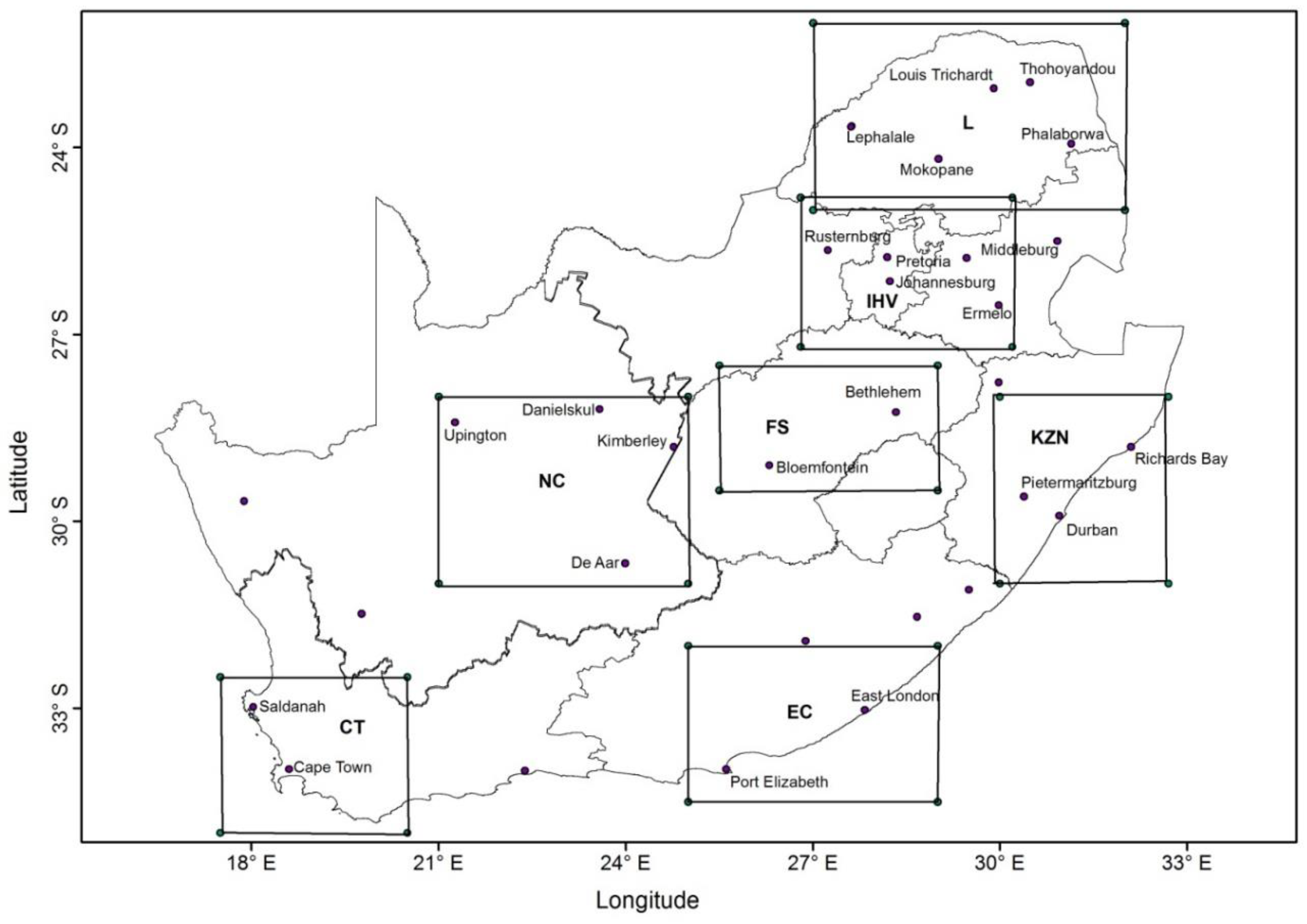
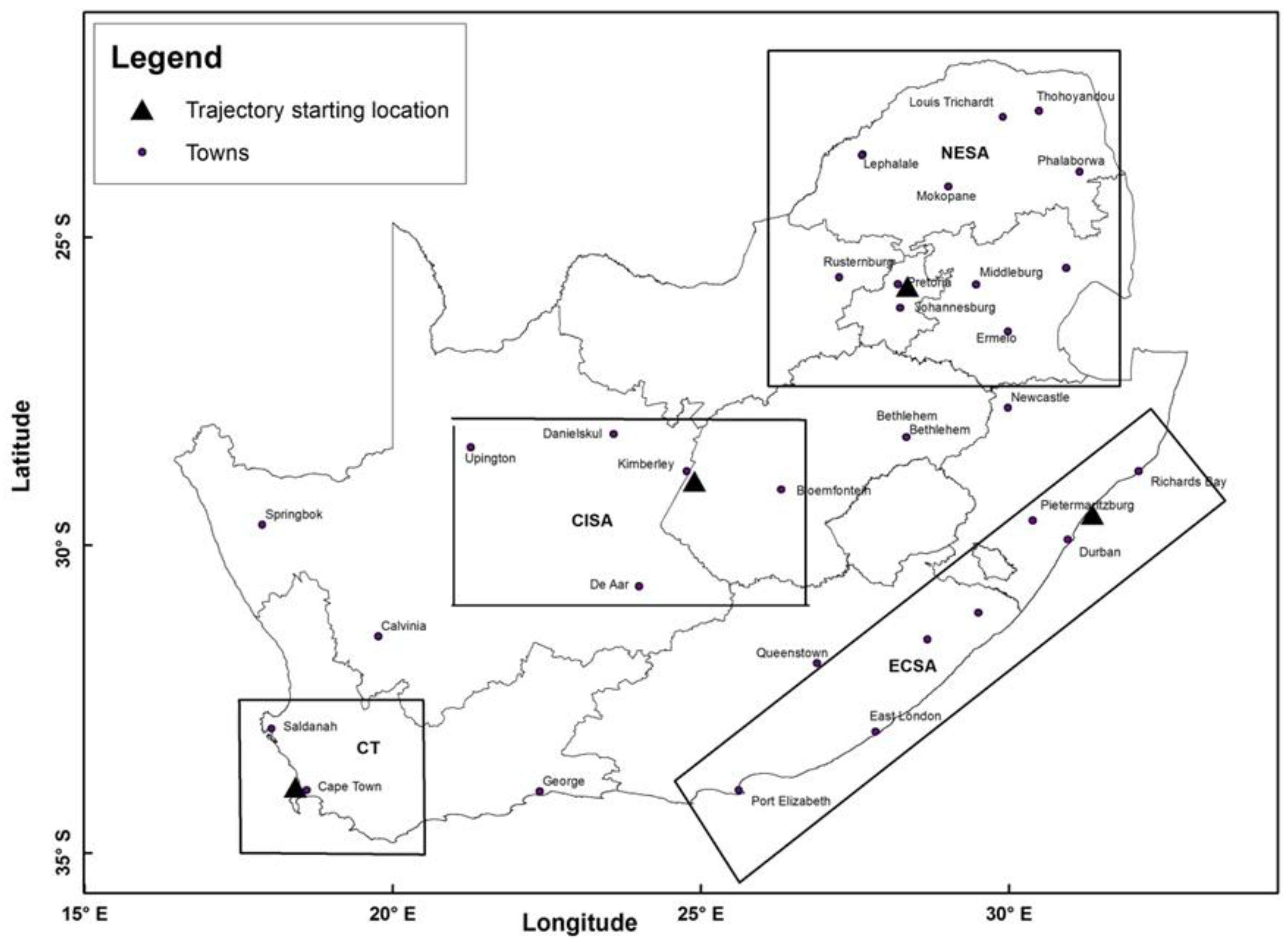
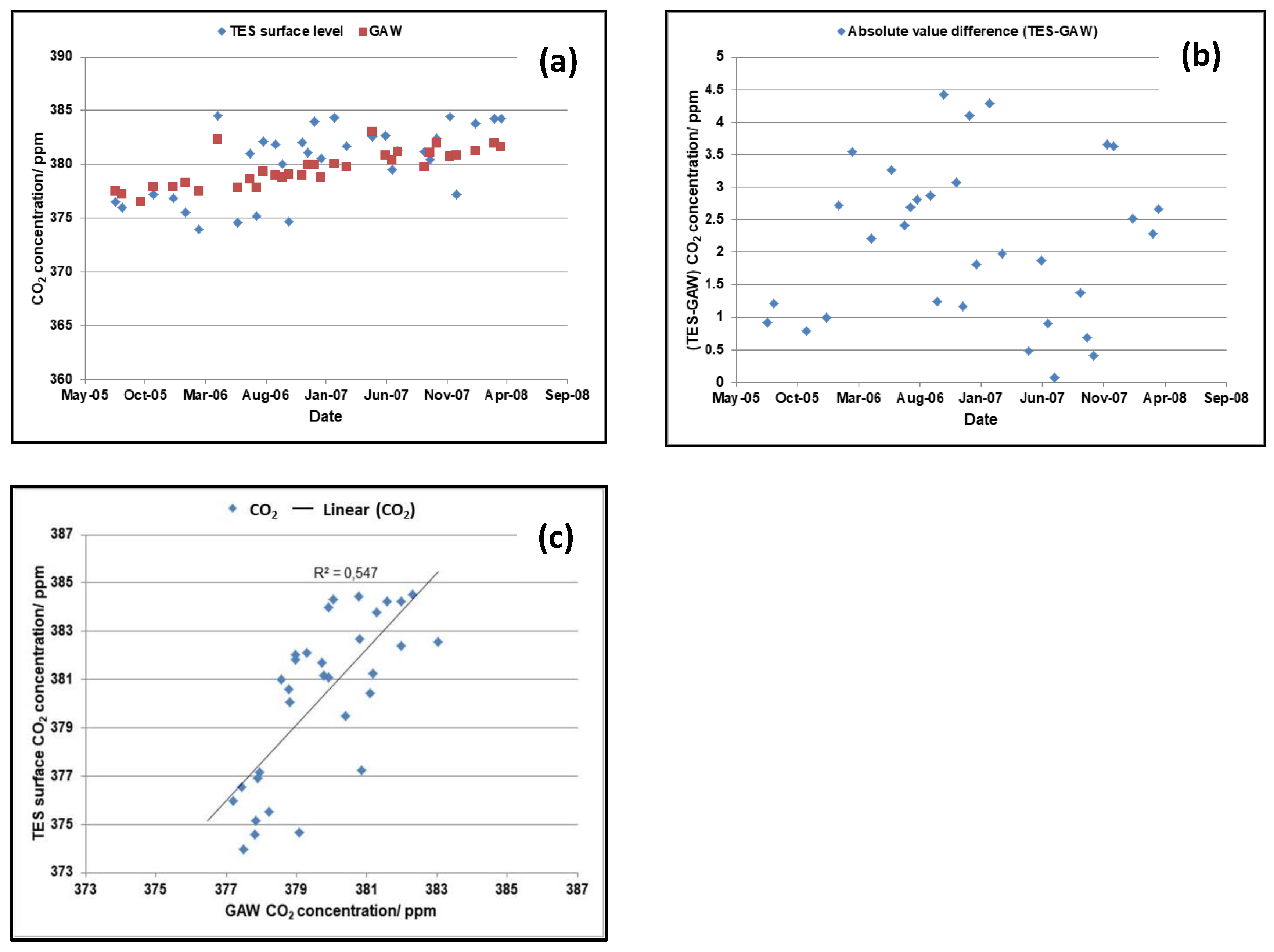
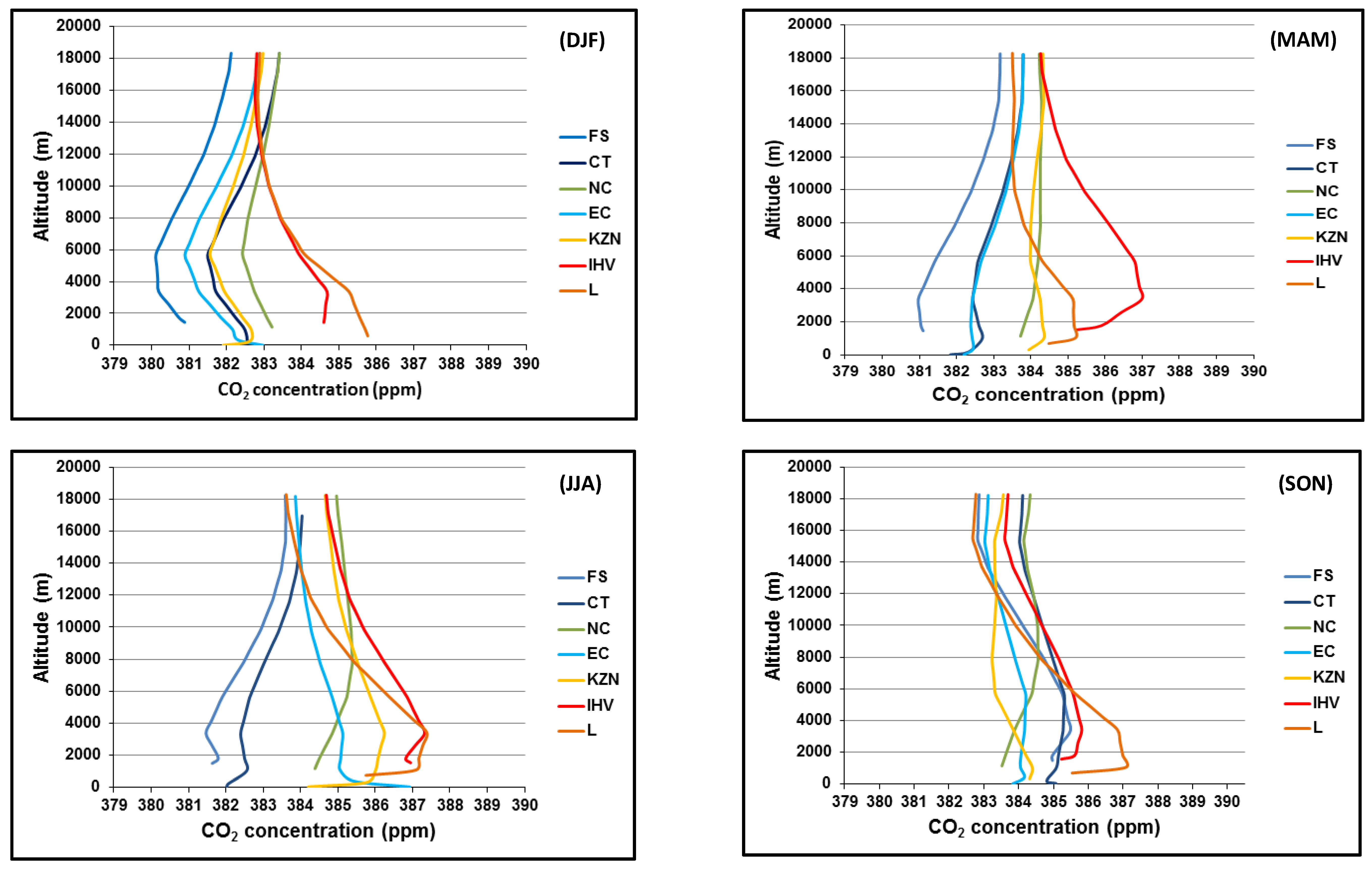
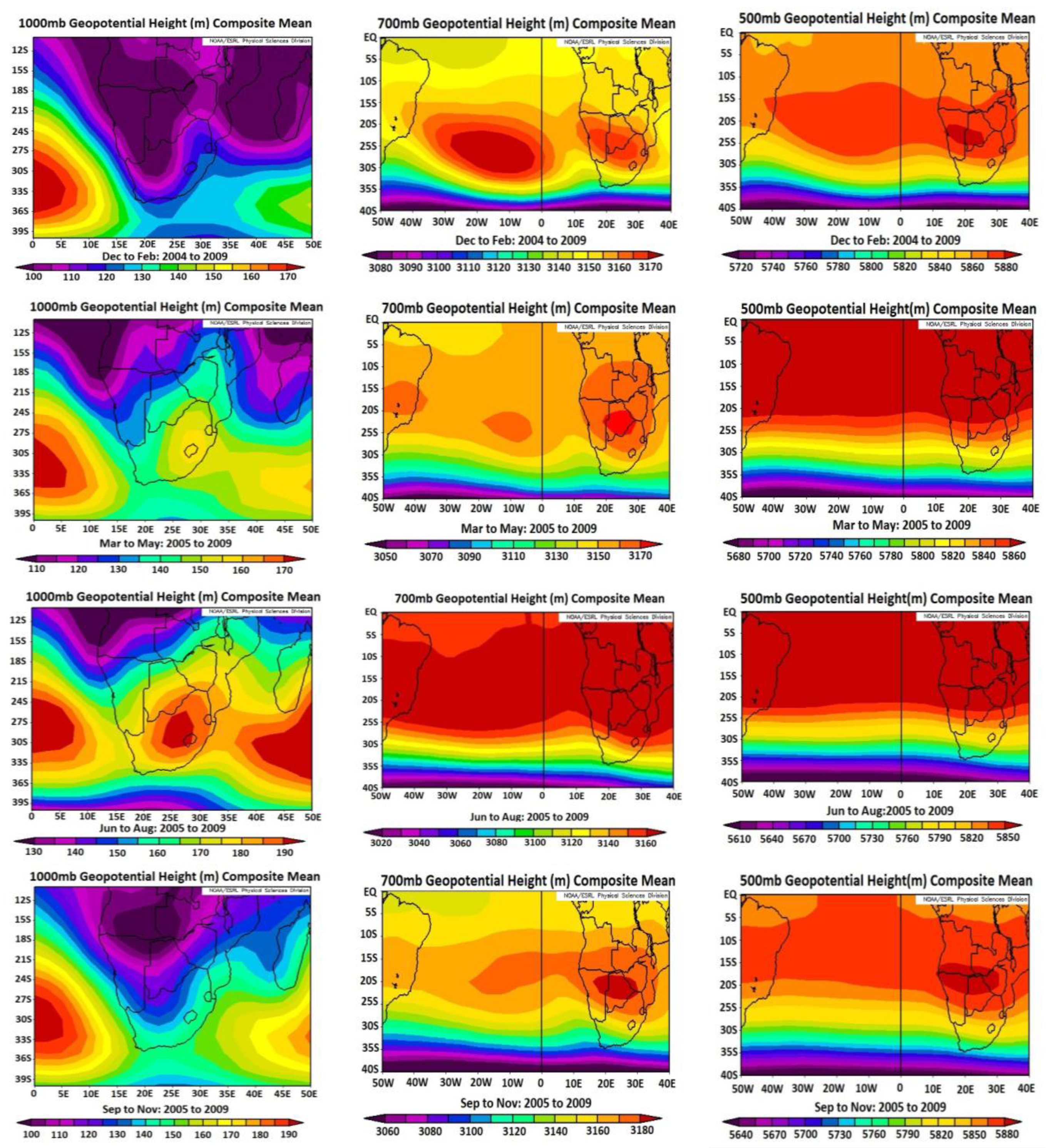
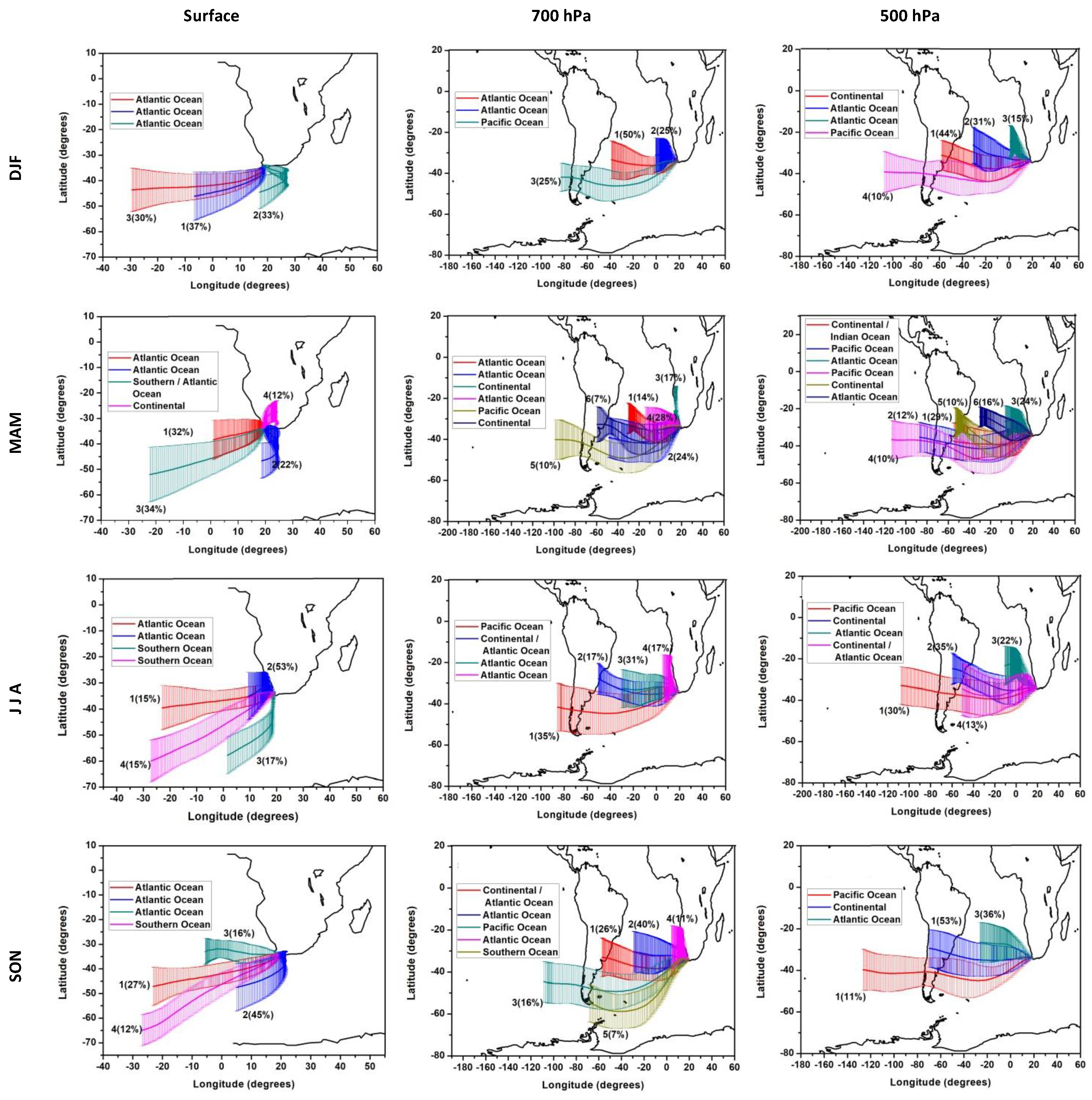
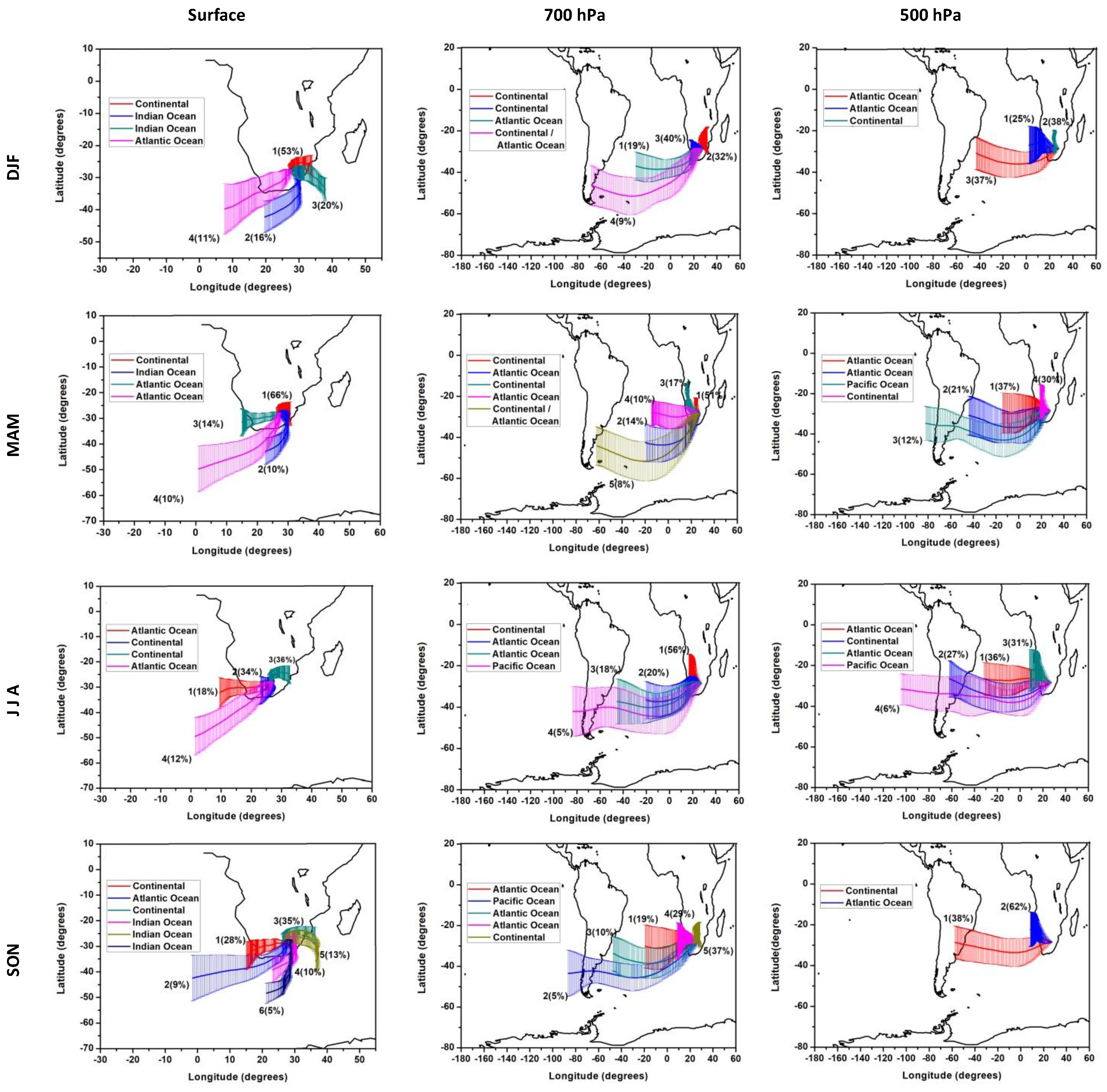
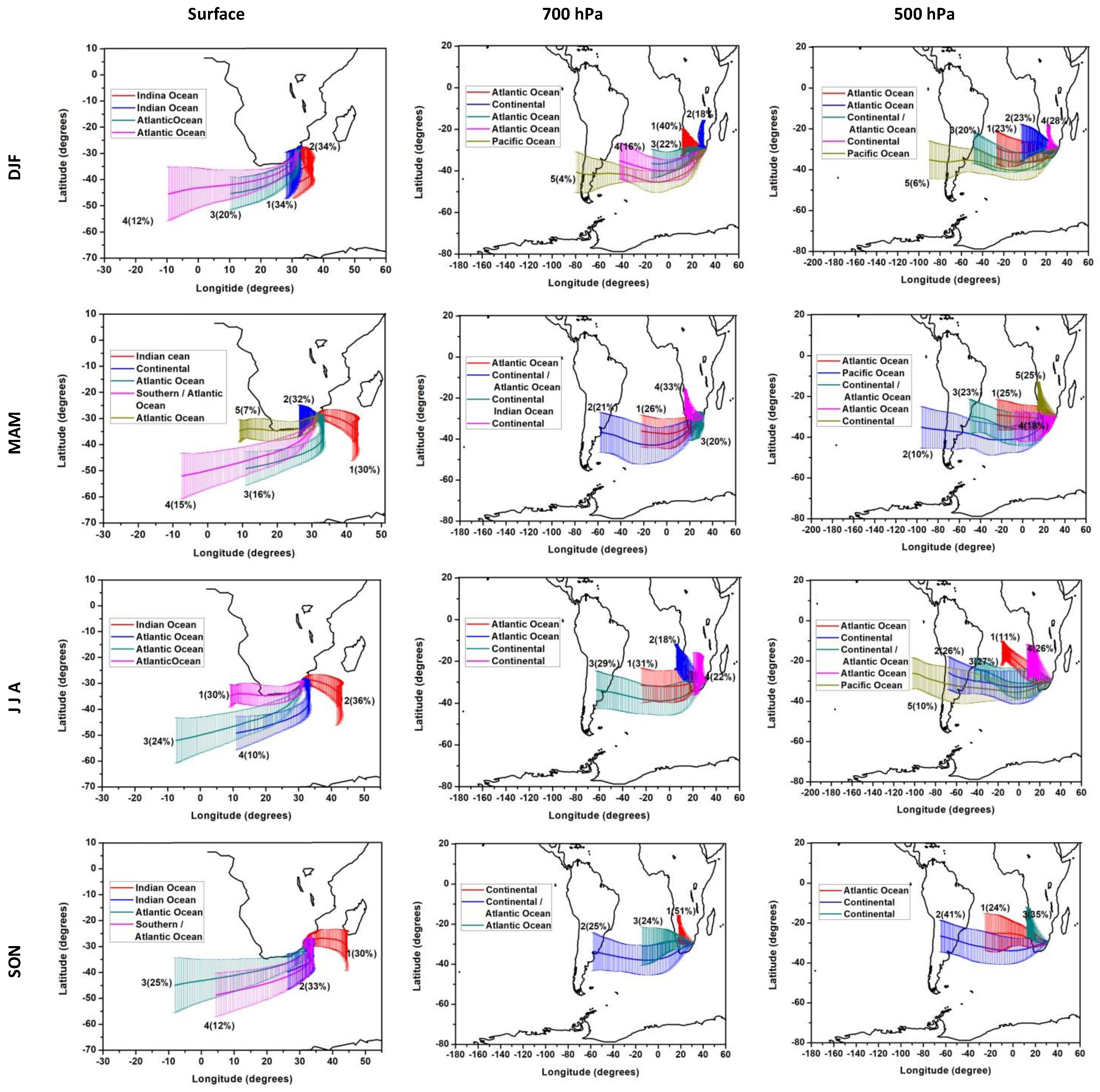
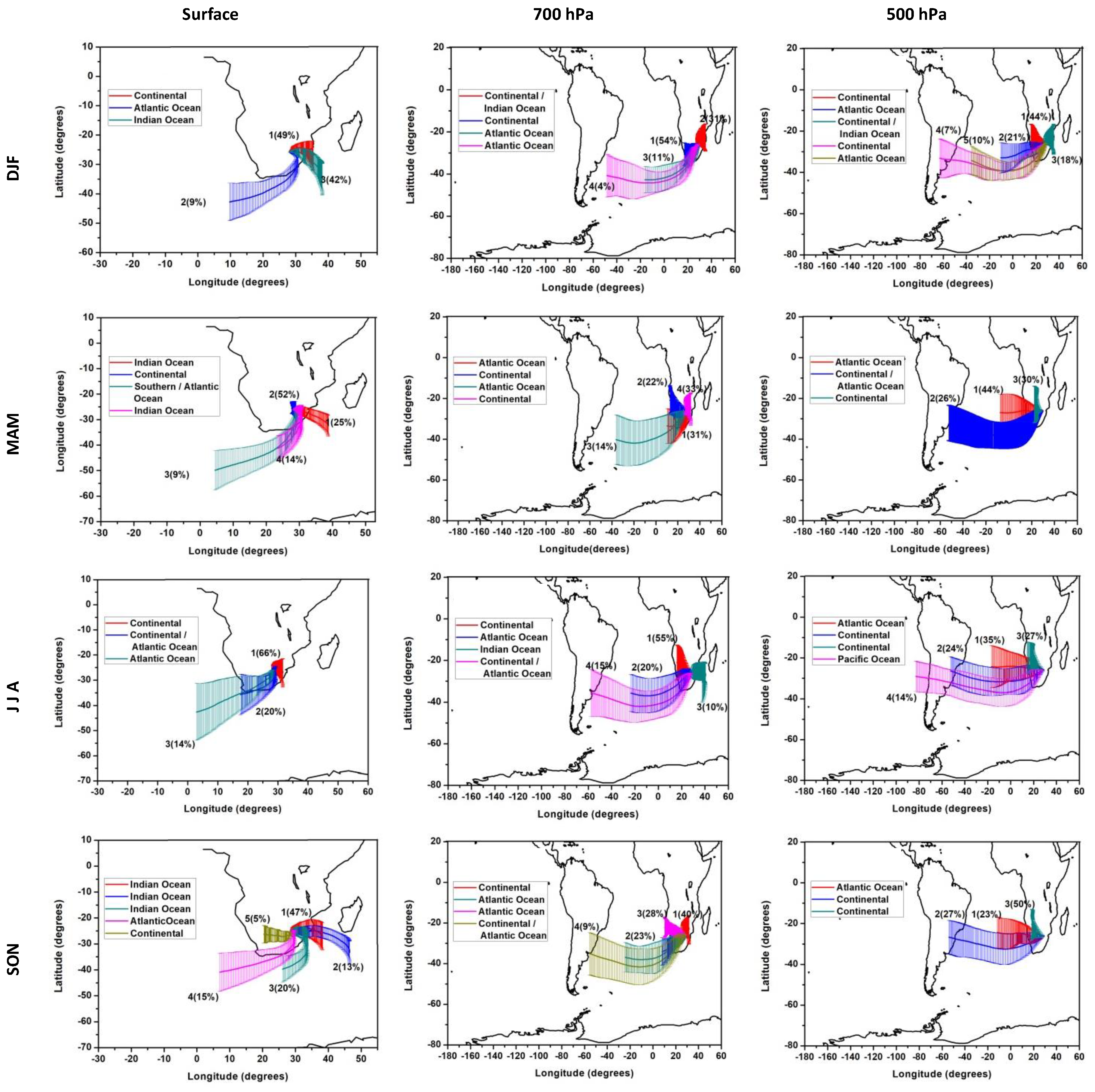
| Area | Latitude Range (° S) | Longitude Range (° E) |
|---|---|---|
| Cape Town (CT) | 32.5° to 35.0° | 17.5° to 20.5° |
| Central Freestate (FS) | 27.5° to 29.5° | 25.5° to 29.0° |
| Central Northern Cape (NC) | 28.0° to 31.0° | 21.0° to 25.0° |
| Eastern Cape (EC) | 32.0° to 34.5° | 32.0° to 34.5° |
| KwaZulu-Natal (KZN) | 28.0° to 31.0° | 30.0° to 32.7° |
| Industrial Highveld (IHV) | 24.8° to 27.2° | 26.8° to 30.2° |
| Industrial Highveld (IHV) Limpopo (L) | 22.0° to 25.0° | 27.0° to 32.0° |
| Area | Starting Location | Starting Location Altitude (m) | Starting Location Height (magl) |
|---|---|---|---|
| Cape Town (CT) | 18.42° E, 33.93° S | 0.0 | 50.0 |
| 3600.0 | |||
| 6000.0 | |||
| Central Interior of South Africa (CISA) | 27.1° E, 28.5° S | 1400.0 | 50.0 |
| 2200.0 | |||
| 4500.0 | |||
| East Coast of South Africa (ECSA) | 31.35° E, 29.5° S | 0.0 | 50.0 |
| 3600.0 | |||
| 6000.0 | |||
| North East of South Africa (NESA) | 28.35° E, 25.8° S | 1400.0 | 50.0 |
| 2200.0 | |||
| 4500.0 |
© 2020 by the authors. Licensee MDPI, Basel, Switzerland. This article is an open access article distributed under the terms and conditions of the Creative Commons Attribution (CC BY) license (http://creativecommons.org/licenses/by/4.0/).
Share and Cite
Ncipha, X.G.; Sivakumar, V.; Malahlela, O.E. The Influence of Meteorology and Air Transport on CO2 Atmospheric Distribution over South Africa. Atmosphere 2020, 11, 287. https://doi.org/10.3390/atmos11030287
Ncipha XG, Sivakumar V, Malahlela OE. The Influence of Meteorology and Air Transport on CO2 Atmospheric Distribution over South Africa. Atmosphere. 2020; 11(3):287. https://doi.org/10.3390/atmos11030287
Chicago/Turabian StyleNcipha, Xolile G., Venkataraman Sivakumar, and Oupa E. Malahlela. 2020. "The Influence of Meteorology and Air Transport on CO2 Atmospheric Distribution over South Africa" Atmosphere 11, no. 3: 287. https://doi.org/10.3390/atmos11030287
APA StyleNcipha, X. G., Sivakumar, V., & Malahlela, O. E. (2020). The Influence of Meteorology and Air Transport on CO2 Atmospheric Distribution over South Africa. Atmosphere, 11(3), 287. https://doi.org/10.3390/atmos11030287






